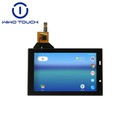The application of privacy filter on capacitive touch screen has significant privacy protection effect. By blocking the side view of the display, it can effectively prevent others from peeking at the screen content, thus protecting the user's privacy. At the same time, the privacy filter also has good technical compatibility and applicability, and can be applied to a variety of capacitive touch screen devices and scenarios. Therefore, for users who need to protect their privacy, privacy filters are an option worth considering.
Privacy filter principle:
1. Optical design principle
Privacy filters control the direction of light propagation on the screen through specific optical designs, such as micro-blind structures or polarized light technology.
Micro-blind structures:
Privacy filters contain a number of tiny shutter structures that block light from the sides of the screen while allowing light from the front to pass through.
When the user is viewing the screen from the front, light passes through these shutters smoothly, resulting in a clear image.
When others view the screen from the side, the light is dramatically diminished due to the blocking effect of the shutters, making the content of the screen blurry or difficult to recognize.
Polarized light technology:
Some privacy filters use polarized light technology, which controls the spread of light by adjusting the direction of its polarization.
As screen light passes through the filter, only light that is polarized in the same direction as the filter passes through, while light from other directions is blocked or attenuated.
This technology can also realize the effect of viewing the screen clearly from the front and blurring it when viewed from the side.
2. Material Characterization Principle
Light transmittance and light-blocking properties:
Privacy filters need to have good light transmission to ensure the clarity of the screen content when viewed from the front.
At the same time, it needs to be light-blocking enough to block light from the sides to protect privacy.
Anti-reflective and anti-glare:
To minimize the impact of outside light on screen viewing, privacy filters often also have anti-reflective and anti-glare features.
These features reduce reflections and glare on the surface of the screen and improve screen visibility and contrast.

The main applications for touchscreens with privacy filters:
1. public places:
In transportation hubs such as airports, train stations, bus stations, etc., touch screens with privacy filters can effectively prevent the screen content from being peeped at by the people next to the passengers when they are inquiring information or purchasing tickets.
In coffee shops, libraries, restaurants and other leisure places, users can protect their privacy and avoid leakage of sensitive information when using touch screen devices with privacy filters.
2. Office space:
In open office environments, employees using touch screen monitors with privacy filters can ensure that business secrets and sensitive information are not prying eyes and improve information security.
In conference rooms, negotiation rooms and other occasions that require confidentiality, the use of touch screen devices with privacy filters can prevent the content of the meeting from being leaked.
3. Financial institutions:
In banks, securities, insurance and other financial institutions, touch screen self-service terminals with privacy filters can protect customers' personal information and transaction data from being leaked.
4. Medical institutions:
In hospitals, clinics and other medical institutions, touch screen devices with privacy filters can protect patients' medical history information and privacy.
What are the advantages of touchscreens with privacy filters?
1. Protecting privacy: Privacy filters protect the user's privacy by limiting the viewing angle of the screen so that only the front viewer can see the content of the screen, effectively preventing side peeping.
2. Improve security: In situations where sensitive information needs to be protected, such as financial institutions and healthcare organizations, privacy filters can prevent information leakage and improve overall security.
3. Improve user experience: Privacy filters can also reduce screen reflections and glare, improve screen visibility, and enable users to have a better user experience in both bright and dim environments. Some privacy filters also have an anti-blue light function, which can reduce the blue light emitted by the screen on the eyes.
4. Protecting the touch screen: Privacy filters can also be used as a protective film, which can effectively prevent scratches, stains, fingerprints and dust, protect the touch screen from damage and extend its service life.




